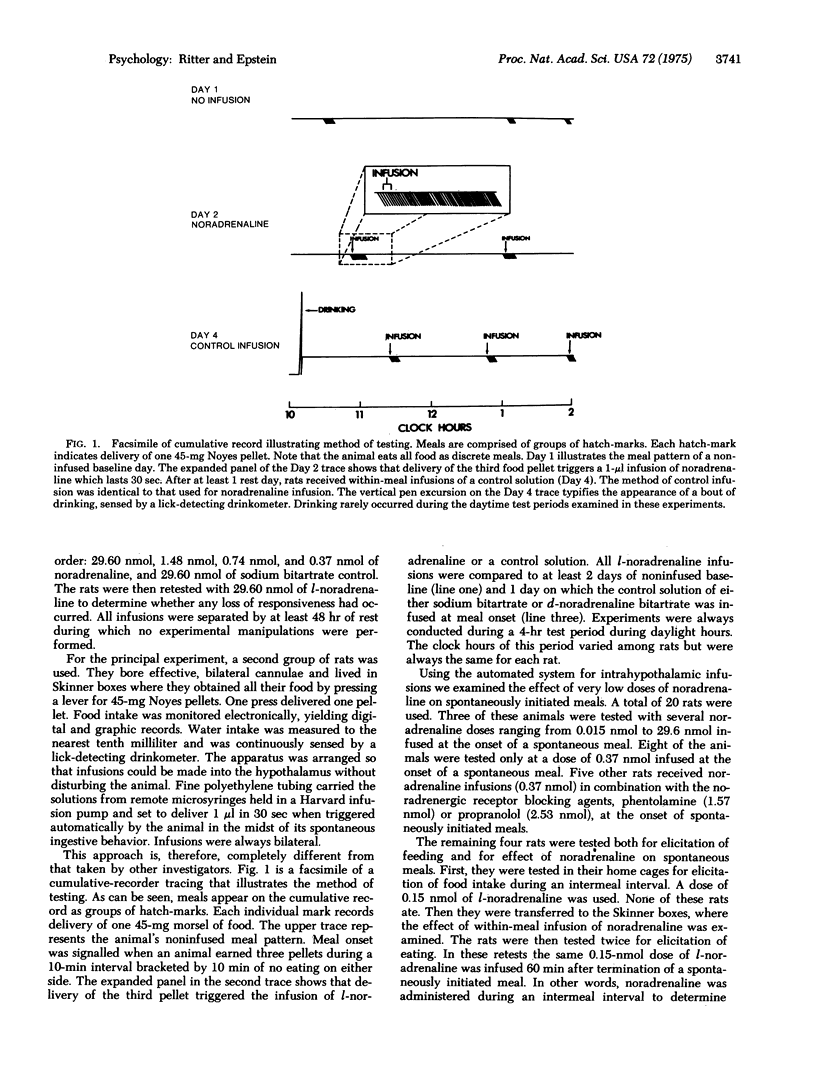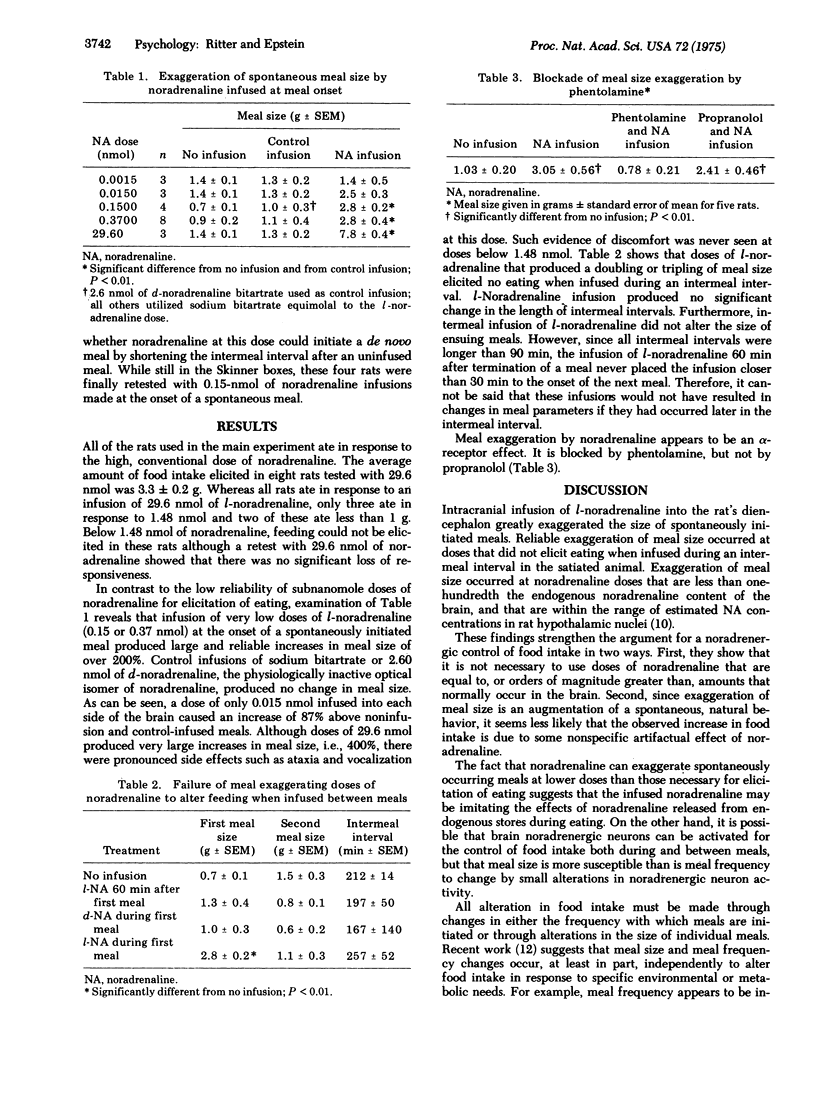Abstract
Previous investigations of central noradrenergic effects on food intake have concentrated on the use of high doses of noradrenaline (two to 200 times brain noradrenaline content). In this work we examined the effect of low doses of noradrenaline (not exceeding brain noradrenaline content) on the parameters of spontaneous ingestive behavior. By arranging for rats to trigger remote infusions of noradrenaline into their own anterior forebrains at the beginning of spontaneously initiated meals, meal size was very reliably increased more than 200% by doses of 0.015--0.37 nmol (2.5--62 ng of noradrenaline base) (n = 12). The effect was alpha-adrenergic. It was blocked by phentolamine but not by propranolol. Infusions of noradrenaline at the above doses, which nearly triple meal size, did not elicit eating when made during an intermeal interval, nor did they influence the length of the intermeal interval when made 60 min after the termination of an uninfused meal. These results show that noradrenaline increased food intake at doses less than 1% of the brain's endogenous noradrenaline content. Meal size is more susceptible to alteration by noradrenaline manipulations than is meal frequency. The brain's own noradrenergic system may function to sustain food intake once feeding is initiated. This function of brain noradrenaline may control spontaneous meal size.
Full text
PDF



Selected References
These references are in PubMed. This may not be the complete list of references from this article.
- Booth D. A. Localization of the adrenergic feeding system in the rat diencephalon. Science. 1967 Oct 27;158(3800):515–517. doi: 10.1126/science.158.3800.515. [DOI] [PubMed] [Google Scholar]
- Booth D. A. Mechanism of action of norepinephrine in eliciting an eating response on injection into the rat hypothalamus. J Pharmacol Exp Ther. 1968 Apr;160(2):336–348. [PubMed] [Google Scholar]
- EPSTEIN A. N. Reciprocal changes in feeding behavior produced by intrahypothalamic chemical injections. Am J Physiol. 1960 Dec;199:969–974. doi: 10.1152/ajplegacy.1960.199.6.969. [DOI] [PubMed] [Google Scholar]
- Evetts K. D., Fitzsimons J. T., Setler P. E. Eating caused by 6-hydroxydopamine-induced release of noradrenaline in the diencephalon of the rat. J Physiol. 1972 May;223(1):35–47. doi: 10.1113/jphysiol.1972.sp009832. [DOI] [PMC free article] [PubMed] [Google Scholar]
- GROSSMAN S. P. Direct adrenergic and cholinergic stimulation of hypothalamic mechanisms. Am J Physiol. 1962 May;202:872–882. doi: 10.1152/ajplegacy.1962.202.5.872. [DOI] [PubMed] [Google Scholar]
- Leibowitz S. F. Hypothalamic beta-adrenergic "satiety" system antagonizes an alpha-adrenergic "hunger" system in the rat. Nature. 1970 Jun 6;226(5249):963–964. doi: 10.1038/226963a0. [DOI] [PubMed] [Google Scholar]
- Leibowitz S. F. Reciprocal hunger-regulating circuits involving alpha- and beta-adrenergic receptors located, respectively, in the ventromedial and lateral hypothalamus. Proc Natl Acad Sci U S A. 1970 Oct;67(2):1063–1070. doi: 10.1073/pnas.67.2.1063. [DOI] [PMC free article] [PubMed] [Google Scholar]
- Levitsky D. A. Feeding patterns of rats in response to fasts and changes in environmental conditions. Physiol Behav. 1970 Mar;5(3):291–300. doi: 10.1016/0031-9384(70)90101-0. [DOI] [PubMed] [Google Scholar]
- Margules D. L. Beta-adrenergic receptors in the hypothalamus for learned and unlearned taste aversions. J Comp Physiol Psychol. 1970 Oct;73(1):13–21. doi: 10.1037/h0030008. [DOI] [PubMed] [Google Scholar]
- Palkovits M., Brownstein M., Saavedra J. M., Axelrod J. Norepinephrine and dopamine content of hypothalamic nuclei of the rat. Brain Res. 1974 Aug 30;77(1):137–149. doi: 10.1016/0006-8993(74)90810-5. [DOI] [PubMed] [Google Scholar]
- Ritter S., Wise D., Stein L. Neurochemical regulation of feeding in the rat: facilitation by alpha-noradrenergic, but not dopaminergic, receptor stimulants. J Comp Physiol Psychol. 1975 Feb;88(2):778–784. doi: 10.1037/h0076402. [DOI] [PubMed] [Google Scholar]
- Snowdon C. T., Epstein A. N. Oral and intragastric feeding in vagotomized rats. J Comp Physiol Psychol. 1970 Apr;71(1):59–67. doi: 10.1037/h0028965. [DOI] [PubMed] [Google Scholar]
- Snowdon C. T. Motivation, regulation, and the control of meal parameters with oral and intragastric feeding. J Comp Physiol Psychol. 1969 Sep;69(1):91–100. doi: 10.1037/h0027941. [DOI] [PubMed] [Google Scholar]


